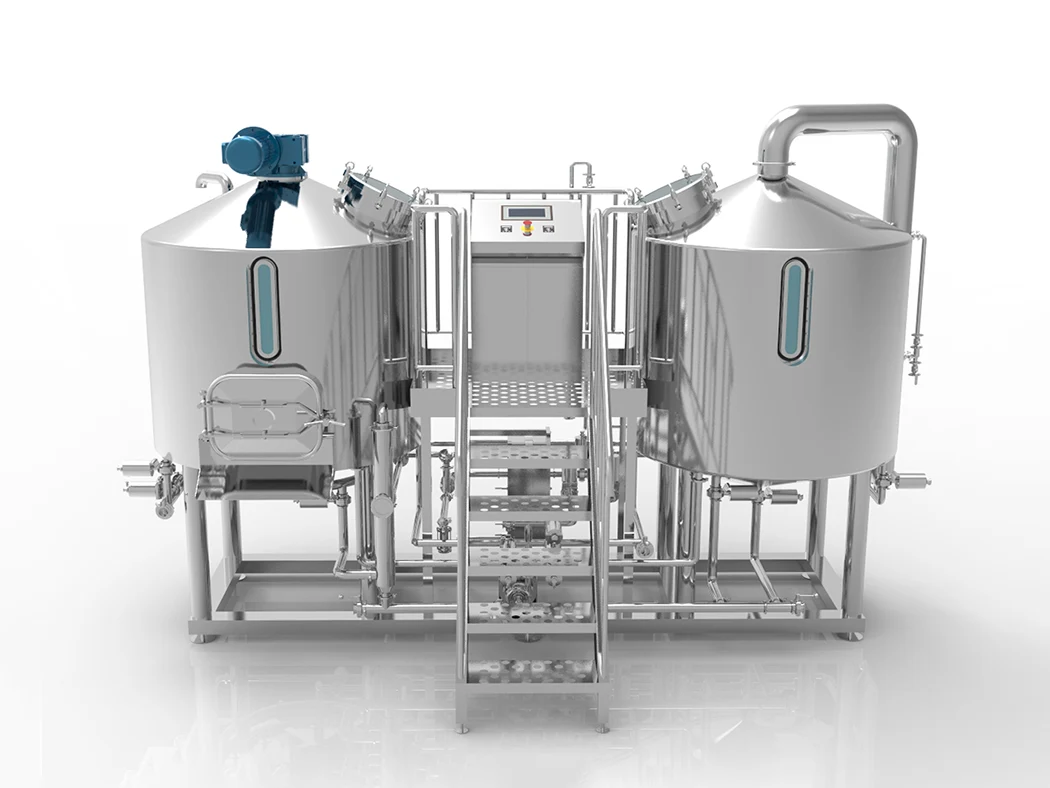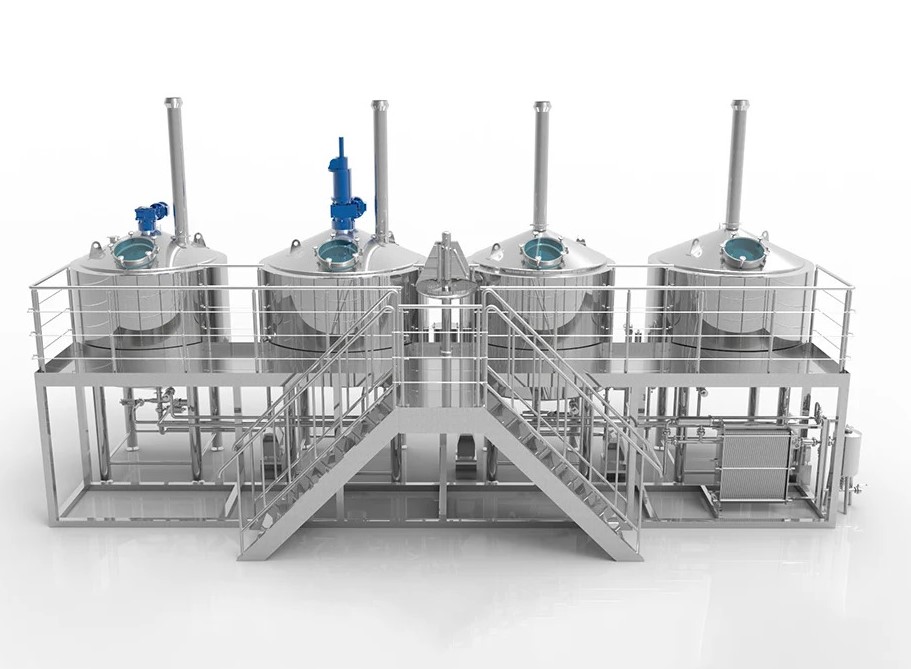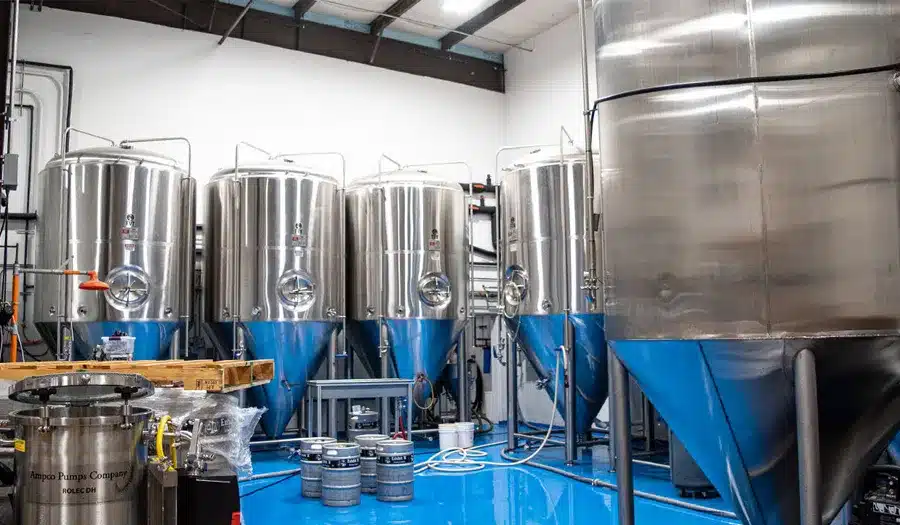Proces vaření piva je složitý a důmyslný a nejkritičtějším krokem je fáze kvašení. Kvašení je proces přeměny maltózy na alkohol a oxid uhličitý, obvykle působením kvasinek. Na trhu existuje celá řada kvasných nádob pro domácí vaření piva s různými velikostmi a různými typy nádob, které jsou vhodnější pro různé typy kvašení. V celém procesu vaření piva je výběr a použití kvasných nádob zásadní, protože přímo ovlivňují kvalitu, chuť, čirost a dobu skladování piva.
Co je to nádoba na kvašení piva?
Při vaření piva je zásadní fází kvašení. Pivovar nejprve uvede zcukernatělou sladovou tekutinu (mladinu) do kontaktu s kvasinkami, které se při vhodné teplotě rozmnoží a spotřebují cukr obsažený v mladině, přičemž nakonec vznikne alkohol a oxid uhličitý. Aby tento proces probíhal hladce, musí pivovarník zvolit vhodnou kvasnou nádobu. Kvasná nádoba musí být nejen schopna pojmout pivní tekutinu, ale také poskytnout vhodné prostředí pro kvasinky a zároveň zabránit vnější kontaminaci.
Volba kvasné nádoby úzce souvisí nejen s chutí a kvalitou piva, ale ovlivňuje také účinnost a stabilitu procesu vaření. Obecně lze kvasné nádoby rozdělit na nádoby pro primární kvašení a nádoby pro sekundární kvašení podle jejich fází použití a funkcí. Nádoby pro primární kvašení se používají v počáteční fázi kvašení, zatímco nádoby pro sekundární kvašení se používají pro následné zpracování a čiření piva.
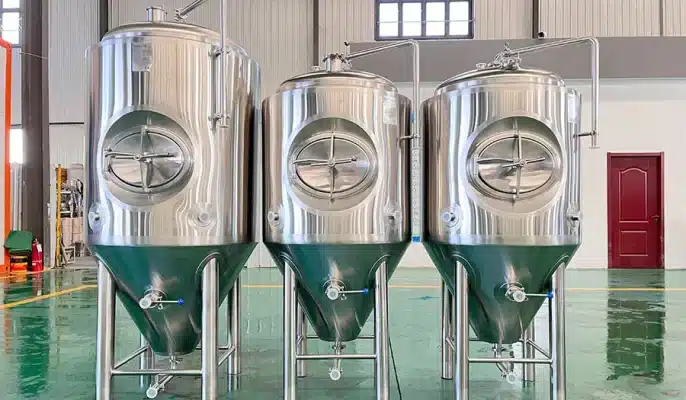
Materiál fermentační nádoby
Plastová fermentační nádoba
Plastové kvasné nádoby se většinou používají pro domácí vaření piva a levnou malovýrobu. Mezi běžné plastové materiály patří vysokohustotní polyethylen (HDPE) a polypropylen (PP). Tyto materiály mají silnou odolnost proti korozi a dobré těsnicí vlastnosti.
Výhody
- Plastové nádoby jsou relativně levné a jsou běžnou volbou pro domácí vaření piva.
- Plast je poměrně lehký a snadno se přenáší a ovládá.
Nevýhody
- Některé nekvalitní plastové materiály mohou reagovat s chemickými složkami piva a ovlivnit jeho chuť.
- Plastový povrch se snadno poškrábe, což má za následek obtížné odstraňování nečistot, které následně ovlivňují hygienické podmínky.
Fermentační nádoba z nerezové oceli
Fermentační nádoby z nerezové oceli se běžně používají v oblasti komerčního pivovarnictví a stále častěji je přijímají domácí pivovarníci. Nerezová ocel má vynikající odolnost proti korozi a čisticí vlastnosti, takže je považována za ideální volbu pro vysoce kvalitní varné nádoby. Jako materiál kvasné nádoby se často používá potravinářská nerezová ocel (např. 304 a 316), aby se zajistilo, že pivo nebude během procesu vaření kontaminováno. I když je dlouhodobě vystavena působení alkoholu, kvasnic a dalších tekutých složek, nedojde k jejímu poškození.
Výhody
- Nádoby z nerezové oceli mají hladký povrch, který se velmi snadno čistí a dezinfikuje, což snižuje možnost množení bakterií.
- Nerezové nádoby jsou velmi pevné a odolné, vhodné pro dlouhodobé používání a lze je používat opakovaně po mnoho let.
- Nerezová ocel odolává vysokým teplotám, takže se dobře přizpůsobuje teplotním změnám během procesu vaření, zejména při vysokoteplotních fermentačních procesech.
- Nerezová ocel neuvolňuje žádné pachy ani škodlivé látky, což pomáhá zachovat původní vůni a chuť piva.
Nevýhody
- Nádoby z nerezové oceli jsou poměrně drahé a mohou přesáhnout rozpočet domácího pivovarnictví, zejména velké fermentační nádrže z nerezové oceli.
- V porovnání s plastem a sklem jsou nádoby z nerezové oceli těžší a jejich přenášení není tak pohodlné jako u jiných materiálů.
Skleněná fermentační nádoba
Sklo je materiál, který se běžně používá pro malé fermentační nádoby pro domácí vaření piva. Má dobrou průhlednost, takže pivovarníci mohou sledovat proces kvašení.
Výhody
- Průhlednost skleněných nádob umožňuje pivovarníkům kdykoli sledovat proces kvašení a změny v pivu.
- Sklo neobsahuje chemické látky, což může zajistit, že chuť a aroma piva nebudou ovlivněny.
- Povrch skleněných nádob je hladký a snadno se důkladně čistí, což snižuje riziko bakteriální kontaminace.
Nevýhody
- Skleněné nádoby se snadno rozbijí, proto je třeba být při jejich přenášení opatrný. Při nesprávném používání může snadno dojít k jejich poškození.
- Přestože jsou skleněné nádoby z nerezové oceli lehčí, jsou stále těžší než plastové nádoby a jejich přenášení a skladování může být problematičtější.
- Uvnitř skleněné láhve, jejíž čištění je poněkud problematičtější než u plastových a nerezových nádob, se mohou vyskytovat usazeniny, zejména v pozdějších fázích kvašení.
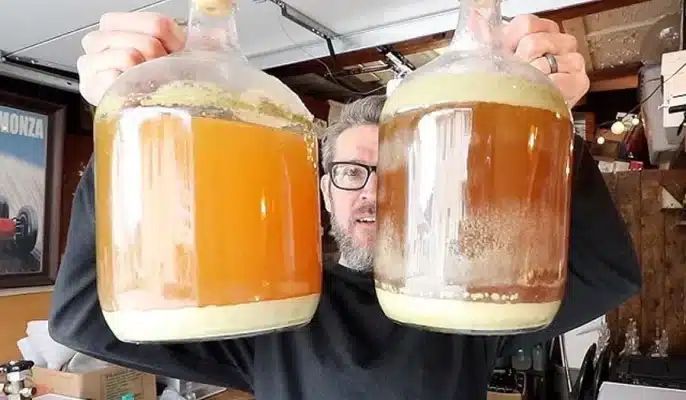
Dřevěná fermentační nádoba
Dřevo není při kvašení piva běžné, ale v některých specifických pivovarských technikách a speciálních pivních stylech hrají dřevěné sudy stále důležitou roli, zejména při výrobě piva v sudech. Materiál dřevěného sudu může pivu dodat jedinečnou chuť a vůni.
Výhody
- Když dřevěný sud přijde během procesu kvašení do styku s pivem, uvolní se z něj aroma a chemické složky dřeva, které pivu dodají jedinečnou chuť a vůni.
- Při kvašení v dřevěných sudech dochází k interakci mikroorganismů a složek dřeva, což často zvyšuje komplexnost a vrstevnatost piva.
- Dřevěné sudy mají v tradičním pivovarnictví významné postavení a pivo vařené v dřevěných sudech má jedinečný smysl pro historii a tradici.
Nevýhody
- Dřevěné sudy vyžadují pravidelnou údržbu a čištění, jinak hrozí jejich kontaminace plísněmi a bakteriemi.
- Je obtížné kontrolovat teplotu a vlhkost při kvašení v dřevěných sudech a pro vinaře je obtížné přesně kontrolovat podmínky vaření.
- Dřevěné sudy jsou drahé a po použití vyžadují zvláštní péči a údržbu, takže náklady na ně jsou vysoké.
Typy nádob pro kvašení piva
V procesu vaření piva má zásadní význam fáze kvašení a výběr kvasné nádoby přímo ovlivňuje kvalitu, chuť, čirost a skladovací účinky piva. Různé typy kvasných nádob jsou vhodné pro různá měřítka vaření a technické požadavky.
Fermentační sudy
Kvasné sudy jsou nejběžnějšími kvasnými nádobami při domácím vaření piva a jsou také běžně používaným nástrojem při výrobě piva v malém měřítku. Fermentační sudy jsou obvykle vyrobeny z plastu nebo nerezové oceli, mají střední objem a snadnou obsluhu, jsou vhodné pro primární kvašení.
výhody:
- Fermentační sudy mají obvykle velkou kapacitu vhodnou pro domácí nebo malovýrobu a pojmou 10 až 30 litrů mladiny ke kvašení.
- Fermentační sudy jsou obvykle vybaveny těsnicími kryty a vzduchovými ventily, které účinně zabraňují přístupu vnějšího vzduchu, zajišťují uzavřenost fermentačního prostředí a snižují riziko oxidace a kontaminace.
- Mnoho kvasných sudů je průsvitných nebo průhledných a pivovarníci mohou snadno pozorovat aktivitu bublinek a změny v pivu během procesu kvašení.
- Ve srovnání s nerezovými a skleněnými nádobami jsou plastové fermentační sudy levné a cenově výhodné, vhodné pro domácí pivovarnické nadšence s omezeným rozpočtem.
Nevýhody
- Plastové fermentační sudy se snadno poškrábou a poškodí a po dlouhodobém používání mohou prasknout, což ovlivní jejich životnost.
- Z nekvalitních plastových materiálů se mohou uvolňovat škodlivé chemické látky, které ovlivňují chuť a vůni piva.
- Plastové sudy jsou náchylné k hromadění pivovarských zbytků, které se obtížně čistí a dezinfikují a mohou se snadno stát živnou půdou pro bakterie.
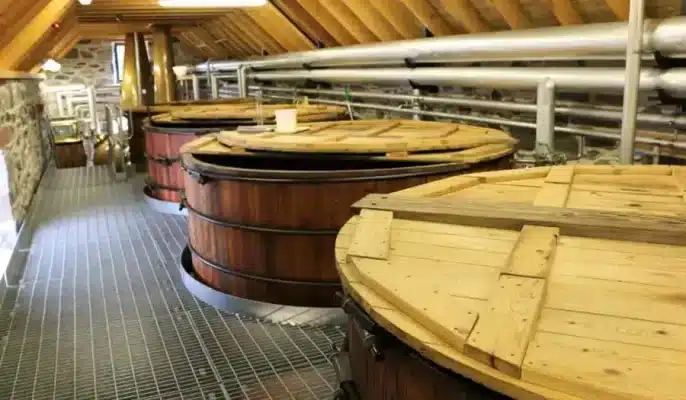
Fermentační nádrže z nerezové oceli
Fermentační nádrže z nerezové oceli jsou jedny z nejčastěji používaných fermentačních nádob v komerčním pivovarnictví a postupně se dostávají i na trh domácího vaření piva. Její materiál má silnou odolnost proti korozi, trvanlivost a snadné čištění, takže se hojně používá při výrobě piva vyšší třídy.
Výhody
- Silná odolnost proti korozi: Nerezová ocel má velmi dobrou odolnost proti korozi, odolává reakci chemikálií v procesu vaření a není snadné ji zkorodovat.
- Zachovejte původní chuť piva: Nerezové materiály neuvolňují žádné látky, které by ovlivňovaly chuť piva, takže mohou zachovat původní chuť piva.
- Snadno se čistí: Povrch nerezové oceli je hladký a velmi snadno se čistí. Dokáže zcela odstranit zbytky po vaření a omezit růst bakterií.
- Dobrá odolnost: Nerezové fermentační nádrže jsou velmi silné a odolné, vhodné pro dlouhodobé používání a není snadné je rozbít.
- Silná vzduchotěsnost: Většina fermentačních nádrží z nerezové oceli je vybavena vzduchovými ventily a těsnicími systémy, které účinně brání vstupu vnějšího vzduchu a udržují stabilitu fermentačního prostředí.
Nevýhody:
- Náklady na fermentační nádrže z nerezové oceli jsou mnohem vyšší než náklady na plastové nádoby, takže je zapotřebí vyšší rozpočet na počáteční investici.
- V porovnání s plastovými a skleněnými nádobami jsou fermentační nádrže z nerezové oceli poměrně těžké a nejsou tak pohodlné na přenášení jako jiné nádoby.
- Některé fermentační nádrže z nerezové oceli vyžadují dodatečnou podporu zařízení, jako jsou systémy regulace teploty, vzduchové ventily atd., jejichž obsluha je poměrně složitá.
Skleněné fermentační láhve
Skleněné kvasné láhve se často používají ve fázi sekundárního kvašení nebo skladování při domácím vaření piva. Protože sklo je průhledné a neovlivňuje chuť, poskytuje pivovarníkům dobrou viditelnost, aby mohli kdykoli sledovat změny v procesu kvašení.
výhody:
- Dobrá transparentnost: Průhlednost skleněných nádob umožňuje pivovarníkům jasně sledovat průběh kvašení a změny v pivní tekutině.
- Neovlivňuje chuť piva: Sklo je neutrální materiál, který nereaguje s pivem a nemění jeho chuť.
- Snadno se čistí: Skleněný povrch je hladký a neabsorbuje snadno zbytky. Poměrně snadno se čistí a je vhodný pro sekundární kvašení.
Nevýhody:
- Křehkost: Skleněné nádoby se při přepravě nebo provozu snadno rozbijí a je třeba je používat opatrně.
- Obtížně se čistí: Přestože je povrch skla hladký, snadno se na něm hromadí usazeniny a zbytky, takže je třeba věnovat čištění zvláštní pozornost.
- Těžká váha: Skleněné nádoby jsou v porovnání s plastovými těžší a nejsou tak pohodlné na přenášení jako plastové a nerezové nádoby.
Výběr fermentační nádoby
Výběr vhodné kvasné nádoby se neřídí pouze materiálem nádoby, ale také zvážením více faktorů. Za prvé, fermentační nádoba musí mít dobré těsnění, aby se zabránilo přístupu vnějšího kyslíku, a tím se zabránilo oxidaci a další bakteriální kontaminaci. Za druhé, nádoba musí být schopna udržet vhodnou teplotu, která je nezbytná pro činnost kvasinek. A konečně, fermentační nádoba musí mít také dostatek prostoru pro oxid uhličitý a pěnu vznikající během procesu kvašení.
ČASTO KLADENÉ DOTAZY
Má výběr kvasné nádoby vliv na chuť piva?
Ano, materiál a konstrukce kvasné nádoby mohou ovlivnit chuť piva. Například kvašení v dřevěných sudech může pivu dodat komplexní chuť, zatímco nerezové a skleněné nádoby mohou zachovat původní chuť piva.
Mohou být nádoby pro primární a sekundární kvašení stejné?
Ano, nádoby pro primární a sekundární kvašení mohou být stejné, ale při skutečném vaření piva obvykle mnoho pivovarů používá dvě různé nádoby, aby od sebe obě fáze oddělilo, a tím zlepšilo čirost a stabilitu piva.
Ovlivní plastové kvasné sudy chuť piva?
Pokud použitý plast nesplňuje normy pro bezpečnost potravin nebo je nekvalitní, může ovlivnit chuť piva, proto je velmi důležité vybrat si kvalitní plastový kvasný sud pro potravinářské účely.
Je skleněná fermentační láhev bezpečná?
Skleněné kvasné láhve vyžadují opatrnost, protože jsou křehčí. Samotné sklo však nemá vliv na chuť piva a je poměrně bezpečnou a běžně používanou nádobou.

